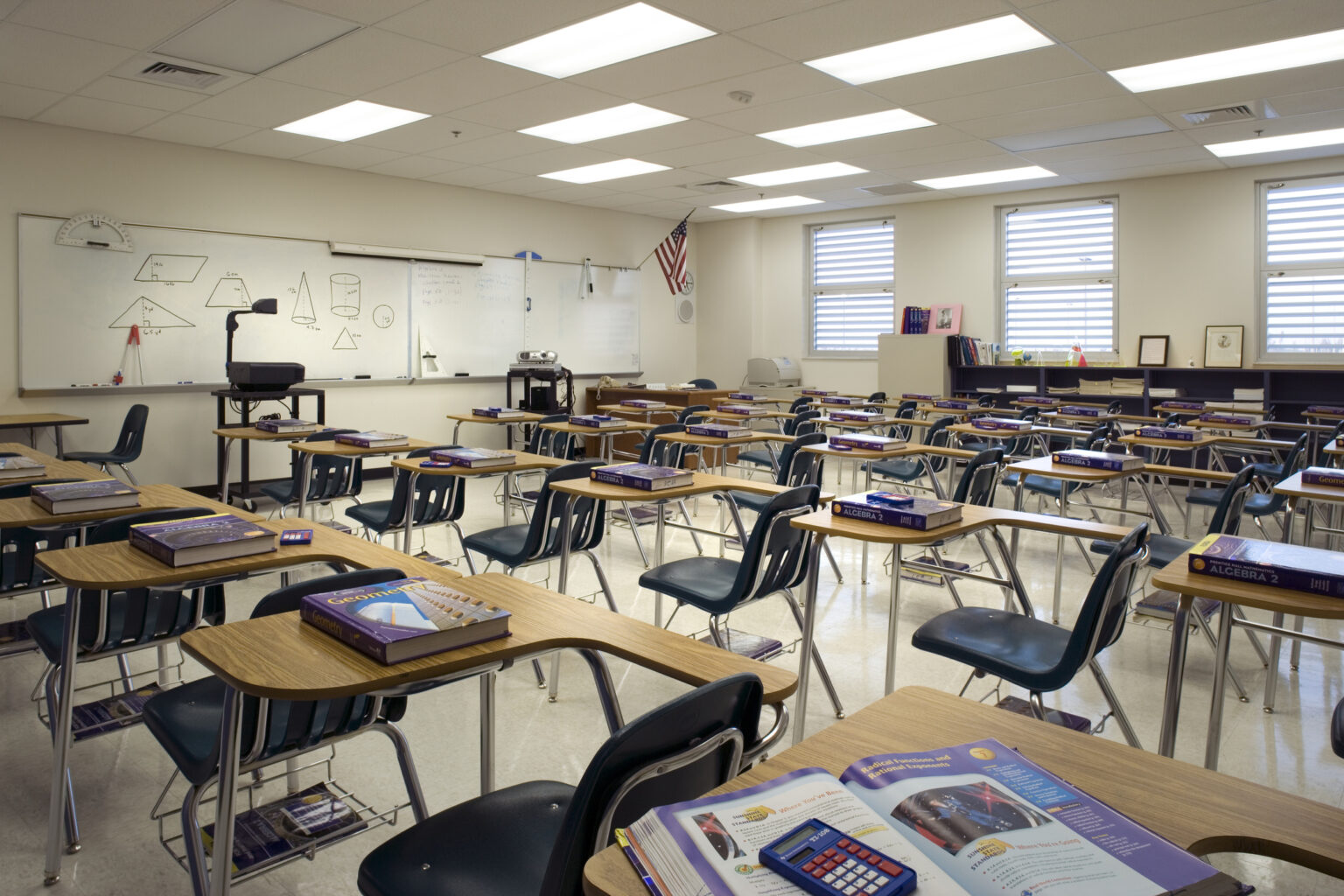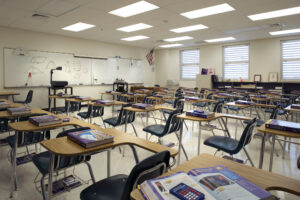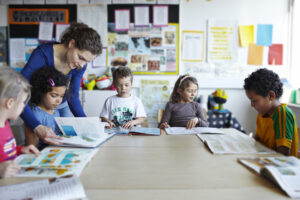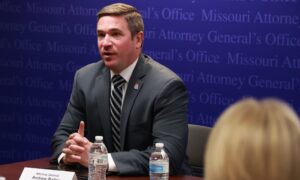7:13
News Story
Kansas City’s $424 million bond proposal would close, renovate and move schools
Superintendent Jennifer Collier understands why families weren’t inspired by the last Kansas City Public Schools building plan.
“It really just felt like … trying to convince people why they should be OK with us taking away their school,” she said.
A new plan to build at least two new schools and renovate others, reshuffle students and close some older buildings has more to offer, she said.
“Any school where the students would be moving, they would typically be moving into new sites, new buildings or highly renovated spaces,” Collier said. “We’re able to actually give our students and our staff and our families something.”
But the district is also asking more of the community — higher property taxes.
KCPS needs to persuade at least four out of every seven voters to approve a general obligation bond in April. The bond allows the district to borrow hundreds of millions of dollars, with the promise that it can raise taxes to pay back the debt.
In many districts, bonds are a routine way to build and update schools. KCPS hasn’t convinced voters to pass a bond in nearly 60 years, though it did receive an influx of money in the 1980s and ‘90s as a result of court-ordered taxing and spending related to a desegregation case. Some of its newer schools were built in that time period.
The lack of a bond has left the district behind on repairs and upgrades. KCPS says it needs $1.25 billion — about $650 million to fix deferred maintenance problems and another $600 million for upgrades. It’s seeking about half of that amount over the next 10 years.
Collier said students notice the difference when they visit other schools.
“All of that impacts the way a child views themselves,” she said. “We want our kids to know they’re important, that they’re worthy, and they have the same kind of spaces and learning environments as other children.”
The initial bond proposal was presented to the school board Aug. 14, but it won’t be finalized until November. Between now and then, residents can weigh in. Here’s what you need to know.
What is a bond?
A bond is a way for a school district to borrow money for big building projects, ones it wouldn’t be able to afford as part of its normal yearly budget.
KCPS would pursue two types of bonds under the current proposal.
A general obligation bond requires voter approval and would result in higher property taxes.
A certificate of participation bond doesn’t require a vote and doesn’t raise taxes, but it would cover a smaller amount of money.
How much money is the district seeking?
Overall, KCPS wants to raise $680 million for its 10-year building plan.
In the first stage of the plan, it would borrow $100 million, and ask voters to approve another $424 million bond in April 2025.
Charter schools, which can’t borrow against the ability to raise taxes on their own, might also participate. Eight of the 20 local charter schools are interested and have building needs totaling more than $168 million.
They’ll prioritize those needs, include up to $50 million worth in the bond and finalize agreements with KCPS by October. That could push the bond total to $474 million.
During the second half of the plan, KCPS would seek the remaining $156 million, including through another bond.
How much would my taxes go up?
KCPS predicts that for a $474 million bond, someone with a home valued at $200,000 would pay an additional $231.80 per year in additional property taxes. A commercial property with the same value would pay an additional $390.40 per year.
The median home value in the district is $180,000, Deputy Superintendent Derald Davis said.
How will the money be used?
Funds will be used in three main areas:
- Deferred maintenance, such as roof repair, electrical, HVAC and plumbing.
- Making buildings more suitable for teaching and learning.
- Moving sixth graders out of elementary schools and into middle schools.
During Phase I of the plan, the district plans to spend:
- $64.2 million on deferred maintenance and improvements in 18 schools.
- $136 million building two new schools.
- $104.8 to 135.4 million for major renovations at up to four schools.
- $48.9 million to combine four school sites into two.
- $62.4 million to relocate students to five existing school buildings.
KCPS also expects savings as some buildings close.
Some plans are still unsettled.
The proposal includes a new South Middle School to create enough space for sixth graders. KCPS is considering whether it should renovate the closed Southwest High School into a middle school or build a new school at one of two proposed sites.
The district is also considering merging two Montessori schools and making Border Star Montessori into a neighborhood school instead of expanding Hale Cook Elementary School.
Can I influence the bond plan?
KCPS is seeking feedback on the bond plan before the board approves it in November.
“Much of this won’t be a surprise,” Collier said, but “sometimes there are things that maybe we just didn’t think of. Maybe there’s some brilliant ideas out there in our community.”
Would any schools close?
Yes. Phillis Wheatley Elementary School, built in 1955, would close.
Its students would be split between J.A. Rogers and Wendell Phillips Elementary Schools, both built in the 1990s. The district would spend extra money renovating those schools.
That’s the only example of students being scattered to other buildings as a school completely closes — a notable difference from an earlier school closure plan.
But other buildings will close as students move into brand new or renovated buildings, special programs relocate or schools merge into shared sites.
What happens to the building when a school closes?
KCPS can keep a school for future use, demolish it or try to sell it.
While the district has struggled to find buyers for several schools, KCPS has been recognized for its overall success at finding ways to reuse schools and involving the community in school repurposing decisions.
Some schools that closed in the past — like Satchel Paige Elementary School and Southwest High School — could get new life as part of the plan.
What new schools would be built?
KCPS would build two new campuses centered around elementary schools.
One $68 million project at the former King/Weeks site is called the King Empowerment Campus. It would house a new K-5 King Elementary School, a family empowerment center, Richardson Early Learning Center and the Wheatley special education program.
A family empowerment center will include services such as a food pantry, clothing closet, mini laundromat, dental clinic and a site for students to receive physicals, Collier said. The King project is a top priority because the district promised a new school at that location years ago.
The district would spend the same dollar amount on a Woodland Empowerment Campus on the current Woodland site.
It would house a new K-5 Elementary School for Whittier Elementary School students, Woodland Early Learning Center, a family empowerment center and the Global Academy for students new to the U.S.
What schools would move?
King Elementary School would move into a brand new building, vacating the former Kansas City Middle School of the Arts building on the Paseo Academy campus.
George Washington Carver Dual Language Academy would move into that building. The move would allow the program to expand and strengthen its connection to the Paseo dual language program.
Melcher Elementary School would move into the former Carver building, which is newer and in better condition. The school grew dramatically during the 2023-24 school year.
The African-Centered College Preparatory Academy would move out of its current building, which is oversized and built in the 1960s, into the former Satchel Paige Elementary School, built in 1991.
What schools would get major renovations?
Renovations and a new addition at Central High School would allow the school to house career and technical education programs, which could also serve other districts and charter schools.
The district could then close Manual Career and Technical Center instead of doing $100 million worth of work to update the building.
KCPS’ two alternative schools, Success Academy at Knotts and Success Academy at Anderson, would merge at the Knotts location. The district would renovate the building to maintain separation between elementary and secondary students.
Northeast and Central Middle Schools would get renovations aimed at moving sixth graders in from elementary schools. Southwest High School could become a new middle school.
If funding is available, East, Southeast and Lincoln College Preparatory High Schools could also see major renovations, such as a new competition gym or a relocated cafeteria.
What if I’m not moving or getting a new school?
KCPS is suggesting districtwide updates to keep schools “warm, safe and dry” and improve learning environments.
The district would spend between $1.3 million and $6 million on each elementary school in Phase I of the plan. Throughout the 10-year plan, they could receive between $4.5 million and $12.5 million each.
KCPS would also spend between $2.9 million and $6.1 million on each middle and high school in Phase 1. They could eventually receive between $4.8 million and $25.3 million each.
That’s not counting schools reopening, changing buildings or expecting major renovations.
Can buildings improve academics?
Physical spaces are an integral part of how students learn, said Jordan Gordon, the school district’s chief operating officer.
Research shows a connection between certain building improvements — especially fixing infrastructure like heating and air conditioning, roofs, plumbing and furnaces — and higher achievement.
”They have (a) real impact on our students’ ability to learn and process information,” Gordon said.
What happens if the bond doesn’t pass?
If the bond doesn’t pass, KCPS will evaluate what went wrong and prioritize projects that keep schools safe and clean, Gordon said, but will be limited by how much money it can set aside.
“We’ll continue to find ways to do the best we can,” he said. “But candidly speaking, that is not a sustainable way, a proper way, to support kids’ education.”
This article first appeared on Beacon: Kansas City and is republished here under a Creative Commons license.![]()
Our stories may be republished online or in print under Creative Commons license CC BY-NC-ND 4.0. We ask that you edit only for style or to shorten, provide proper attribution and link to our website. AP and Getty images may not be republished. Please see our republishing guidelines for use of any other photos and graphics.





